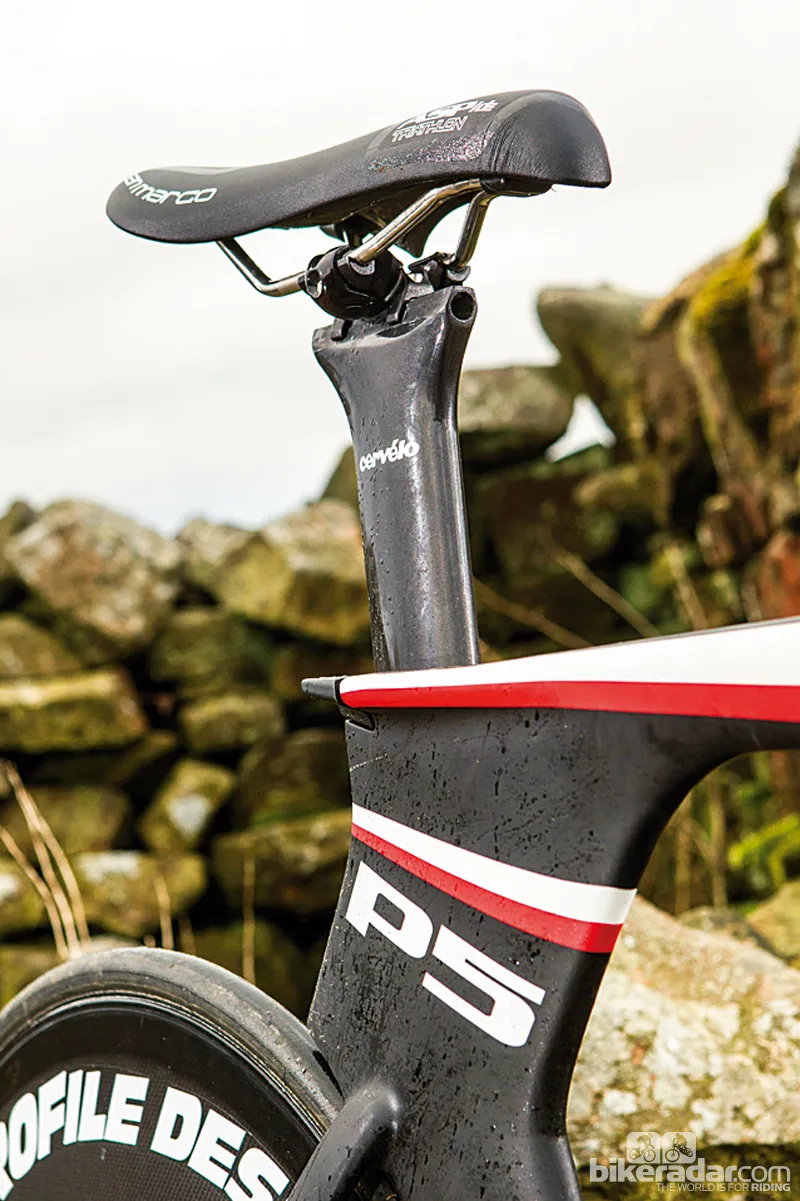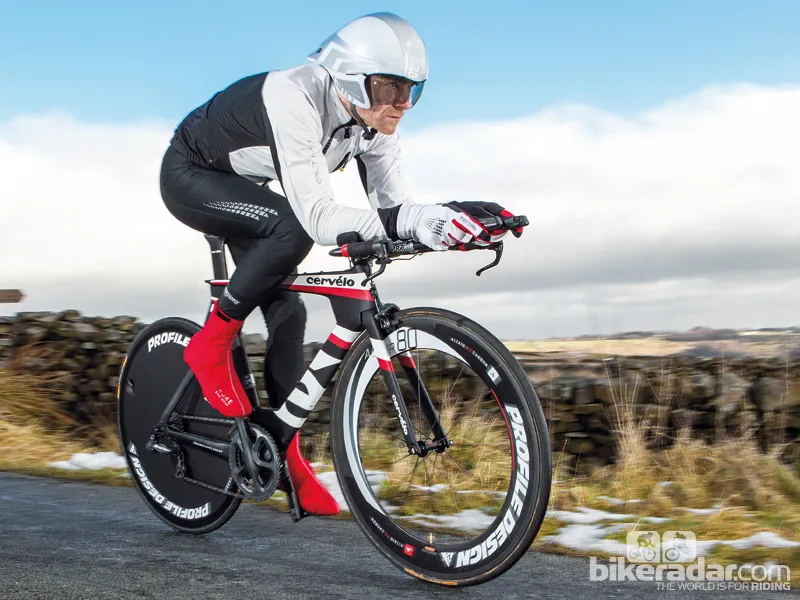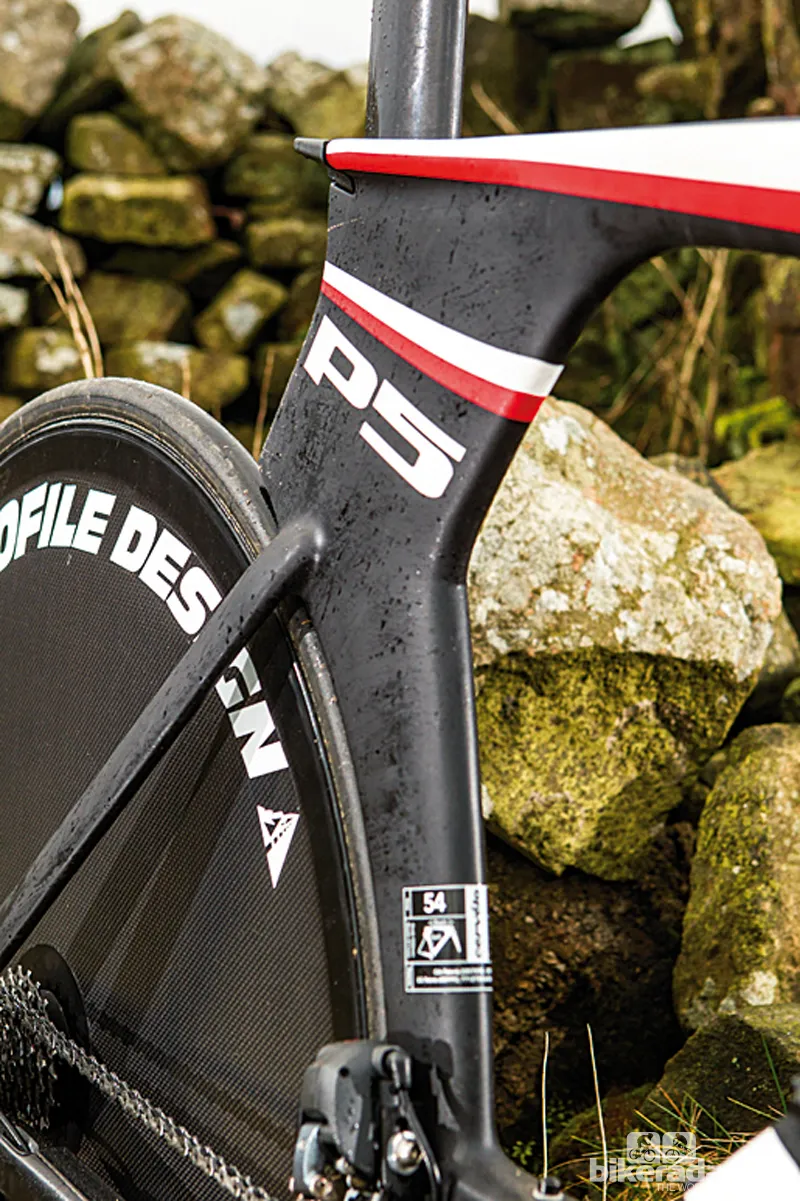Cervélo’s ‘fastest bike ever’ is high on the must-have list of many time triallists. Unfortunately, the UCI illegal version – the P5 Tri – is as rare as hen’s teeth, so we tested the currently more available ‘conventional’ P5.
Ride & handling: Brutally stiff, jaw droppingly fast
While it’s forgiving in terms of what componentry it will let you use, there’s absolutely no forgiveness in the P5’s ride. The first ride out was done with a rushed cockpit and seating setup, and we came home feeling like we’d ridden through a dry stone wall.
Even when it felt like a bag of hammers it still clocked a test stretch PB though, so we set about giving the bike the respect it deserved before our subsequent test rides. Even when the position is perfect, the P5 is a stripped-out bucket seat and big-bore exhaust rally-car-style ride.
If the Comfort Ply softening in the structure is doing anything, we dread to think what the P5 would be like without it. Whether you’re on the horns out of the saddle or flat-backed and flat out, there’s no sense of any filter between you and the road.
Any holes you don’t dodge will knock the stuffing out of you. Kick too hard out of the saddle and the back end will jump and jar, despite the fact that the skinny forks are noticeably soft sideways when it comes to hard cornering or out-of-the-saddle wheel rub.

The Cervélo seatpost has an infinite sliding rail top
The reward for gritting your teeth and grabbing the P5 by the horns is probably the most ferociously focused speed we’ve ever experienced. Our test rides left us aching, but they also left us with a string of beaten Strava PBs.
We’re not talking an easy cruise to victory though, but a screaming death-or-glory charge that the P5 inspired in us. In fact the sheer amount of clatter and roar that accompanied our record runs actually made it feel slower than some other TT machines, but head-to-head or on the stopwatch there was no doubting the sheer speed of this beast on the road.
Frame & equipment: Excellent conventional component and storage option versatility
While it might not have the bearded 6:1 depth to width ratio fork that upsets the road rulemakers so much, or Magura’s hydraulic brakes and the dedicated 3T aerobar as standard, the P5 Three is certainly still a radical machine.
The head tube is still super deep even without a fairing up front. The forward sloping edge to the seat tube section takes the ratio rules to the limit too, running parallel to the deep down tube. The lower down tube joins the seat tube above the level of the chainring to create a really deep section above the BBright multi-axle compatible press-fit bottom bracket.
In fact, even before you add the various aftermarket storage boxes available, there’s already little space left inside the main triangle for wind to get through and mess up airflow.
Cervélo’s much-copied wheel-wrapping curved TrueAero seat tube gets a fin to feed air cleanly onto the top of the rear tyre, while twin bolts secure the almost vertical seatpost. While posts and brakes differ, the super deep asymmetric chainstays and slim wing seatstays are the same on both frames.
Both apparently use elements of the Comfort Ply vibration-reducing carbon weave of the R5 road frame to isolate the rider from road sting, and Cervélo also offer the widest range of frame sizes.

The UCI-legal bike gets a standard ‘in the wind’ front brake
Even allowing for internal cabling and a 172g rear brake, we can see why Cervélo have been reticent about revealing the extremely high 1,800g frame weight, although it is offset by a very light fork.
While Cervélo have certainly done their work in the wind tunnel, the P5 has been designed to be as versatile in kit terms as possible. For example, while the Tri version is supplied with a dedicated aero bar, both bikes use a conventional 1.125in steerer tube that allows you to attach any stem and aerobar you want.
The brake mounts are conventional rather than V-brake or integrated specific too, and there’s space for up to 27mm wide rims without cutting down your brand new brake pads.
The internal rear brake cabling is smooth and straight to keep the lever feel clean. The same applies to gear routing, although our build came wired with Shimano Di2. If you’ve got the budget we’d definitely go digital, as the ability to shift perfectly from horns or extensions puts Di2 in a different class to cable systems when it comes to fuss-free gearing and positional efficiency.
To keep our testing as fair as possible, we also swapped the deep-section Profile Design front wheel and disc our bike was supplied with for a pair of Zipp 808s, which is the wheelset that Cervélo originally designed the bike around.
This article was originally published in Triathlon Plus magazine, available on Zinio.


